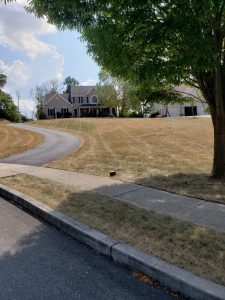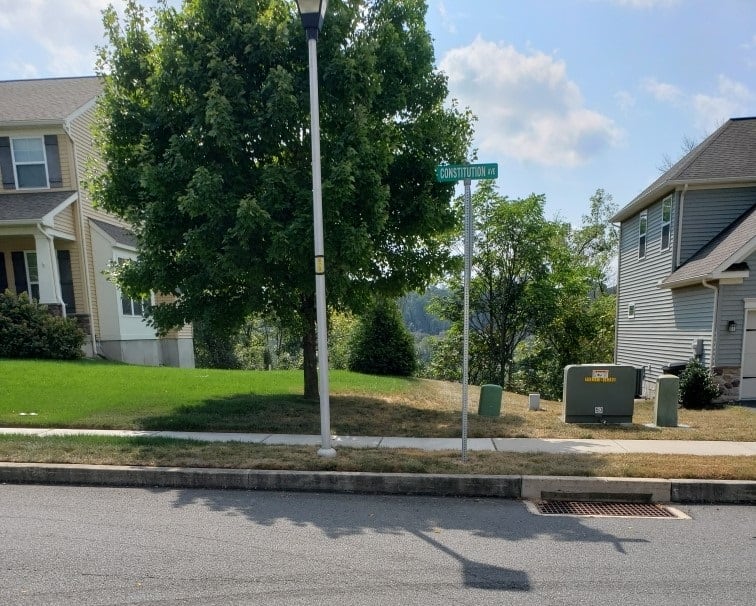Lawn Care During a Drought: What to Do?
It’s no secret that Pennsylvania is currently experiencing a drought. This can be bad news for your lawn, as it may start to turn brown and some areas may thin-out or die. But don’t worry – there are things you can do to help continue to have a healthy lawn! In this blog post, we will discuss some lawn care tips on how to care for your lawn during a drought.
are things you can do to help continue to have a healthy lawn! In this blog post, we will discuss some lawn care tips on how to care for your lawn during a drought.
Just like any plant, grass needs water to survive. A brown lawn is far from the perfect lawn but, if you follow these tips, your lawn should be fine. During and after a drought, lawns are weakened and it can take until next mid-late spring for them to recover. The best way to help your lawn during a drought is by watering it deeply and less frequently. This will encourage the roots to grow deeper, making the grass more drought-tolerant. (See below for more watering information).
Is My Lawn Dead?
Most often, there will be some areas of your lawn that die off but it depends on a lot of factors:
Sun or Shade?
A lawn that is in full sun will suffer more than a lawn that has large street trees that provide shade.
Landscape Design
Large trees growing in your lawn will take a lot of water out of the soil – and the lawn never wins that battle!
Areas where the lawn meets a hard surface such as a driveway, sidewalk, patio, etc. will do poorly in a drought. Think about how hot a driveway gets – the lawn areas next to the driveway heat up (and dry out) much more than areas in the middle of the yard or the shade. The same goes for other edges of the yard.
Slopes
Areas of a lawn that are on a slope will also struggle more during a drought – because, when it does rain, most of it just runs off.
Mowing Height
If you are mowing your lawn too short, your lawn will have more problems in a drought – and at other times of the year. (See more mowing info below).
While it may look like your lawn is dead, it is most likely just in dormancy. This means that the grass is alive, but it has stopped growing due to the lack of water. This is a defense mechanism of many plants. The water goes down into the root system to survive. When the rain, irrigation, etc, arrives, the plant will hopefully come back.
Once the weather cools down and we get some rain, your lawn should start to green up again. In the meantime, there are a few things you can do to help it along.
Should I Water My Lawn in a Drought?
Watering is the best thing you can do for your lawn during a drought. Even though your lawn might not be growing, it needs water – but you need to do it right!
When Should I Water My Lawn?
This might seem like a silly question but, when you water your lawn is important. Avoid watering your lawn in the evening to prevent lawn diseases. When the grass is wet and there is a lot of humidity, the potential for lawn diseases increases greatly!
Watering your lawn in the morning is a best practice. The sun can help dry off any water that is on the grass blades. The goal is to water the grass thoroughly but, have the grass blades dry before the evening.
Fun Fact: Watering in the middle of the day does not hurt your grass!
The only problem with watering in the hottest part of the day is more of the water will evaporate before it gets down the root system.
- First and foremost, water your lawn deeply but only once or twice a week. For the watering to be effective, you need to apply at least 1-inch of water.
This will help your lawn almost immediately and the roots will grow deeper, which will make your lawn more drought-tolerant. Measure the amount of water being applied from your sprinklers or irrigation system with a rain gauge or empty tuna can to make sure you’re applying enough.
- If you have an irrigation system, make sure it is properly maintained and adjusted for efficient water coverage. Consider installing a “smart” controller that will automatically adjust the amount of water based on local weather conditions. An irrigation system is the best way to water your lawn, but if you don’t have one, hand-watering is the next best option.
This is an example of an irrigated lawn vs. a non-irrigated lawn

Should I Mow My Lawn During a Drought?
- Only mow when it is needed. If your lawn is longer than 5-6 inches, it will need to be mowed. But, if you can wait a little longer between mowings, it will help your lawn retain moisture. Also, when you do mow, don’t remove more than one-third of the leaf blade.
- When you mow, set your mower at the highest setting. This will help the grass retain moisture and prevent it from getting stressed. A lawn that is cut too short is more susceptible to drought stress and is more likely to die. By weight, about 90% of a grass plant is water and your lawn needs any water it can get!
- Do not bag your clippings – let them remain on the lawn to decompose and add nutrients back into the soil. If you have a mulching mower, it will help protect the root system by keeping them cooler and adding moisture back into the soil.
When is it Better Not to Water the Lawn?
If you cannot water through the duration of the drought, it is better to not water at all. If your lawn greens up and then goes back into dormancy it will weaken the grass even more.
Lawns need at least one inch of water per week whether from rainfall or irrigation to stay green during a drought.
What is Green Giant Lawn Care Doing to Help My Lawn During the Drought
- Lawn care during a drought is different than other years but it is manageable. We have been through this many times and we know what works.
- Green Giant Lawn Care is using an organic-based fertilizer that will help your lawn through the drought. The fertilizer provides the important nutrients that the lawn needs now. Whenever we get irrigation, rain, or even dew, your lawn will benefit.
- When it is too hot, we will not use weed control – but, we will return to hit the weeds when it cools down enough.
- There are “Surface Feeding Insects”, like Chinch Bugs, Sod Webworms, and others that will feast on your lawn during the summer. Green Giant has a “Surface Feeding Insect” program (with a great guarantee). If you are not on the program, you might want to consider it.
The Best Thing You Can Do For Your Lawn – Aerate and Over-Seed
Finally, you should Aerate and Over-Seed your lawn every fall. All lawns have damage and decline each year. It can be large patches or just thinning out. Aeration with Over-Seeding will introduce new grass types to fill in areas that have taken a beating.
If you are using a reputable lawn care company, you should be getting high-quality grass seed. Turfgrass research is going on all of the time. Universities and companies perform “trials” each year to determine the best types – so, you should be getting the best type available.
Aeration involves using a special machine to create small holes in the ground, which allows water and fertilizer to reach the roots of your lawn. Over-seeding is simply spreading new grass seed over your existing lawn. This helps to fill in any bare spots. Aeration with Over-Seeding in the fall will give your lawn a head start in the spring, and make it more able to withstand drought conditions. Aeration with Seeding is your best bet to have the perfect lawn every year.
We hope these tips help you keep your lawn looking green during the summer months! If you have any questions or need help getting started, please contact us. We would be happy to assist you.
Will Insects Damage my Lawn
If you’re noticing brown spots, you likely have insects damaging your lawn. Chinch Bugs, Sod Webworms and other “Surface Feeding Insects” can quickly destroy a lawn. If you see any signs of insects, be sure to contact us.
By following these tips for Lawn Care in a drought, you should have a healthy lawn going into next year. So don’t let the drought get you down – take action and enjoy your beautiful lawn all summer long!
Members of Lawn Care Association of Pennsylvania